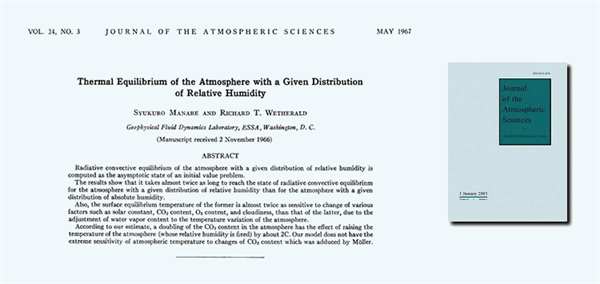
Prof John Mitchell: How a 1967 study greatly influenced climate change science
Professor John Mitchell
07.07.15Professor John Mitchell
07.07.2015 | 2:15pmYesterday, Carbon Brief published the results of our survey of climate scientists asking them to name the most influential studies of all time. The clear winner was a paper published in 1967 written by Syukuro Manabe and Richard. T. Wetherald.
Today, we published an interview with Manabe. Here, Prof John Mitchell, the Met Office Hadley Centre’s chief scientist from 2002 to 2008, explains why the paper has proved to be so significant.
The history of the atmospheric greenhouse effect started almost two centuries ago. In 1824, Joseph Fourier found that thermal (heat or infrared) radiation emitted downwards from the atmosphere, which increased the Earth’s surface temperature beyond that expected due to the Sun’s heat alone. This is known as the greenhouse effect.
In the 1860s, John Tyndall showed the main atmospheric constituents, nitrogen and oxygen, had a negligible greenhouse effect, but minor constituents, including carbon dioxide, had a strong effect.
We now know that the greenhouse gases keep our planet some 30C warmer than it would otherwise be, and that the most important greenhouse gas is water vapour, followed by carbon dioxide.
The first quantitative estimate of the effect of doubling atmospheric CO2 on the mean surface temperature of the Earth was made by Svante Arrhenius in 1896. He allowed for the fact that increasing carbon dioxide would warm the atmosphere and probably increase its water vapour content, enhancing the warming due to the original increase in carbon dioxide – something we now refer to as a “positive feedback”.
The Manabe & Wetherald (1967) paper, Journal of the Atmospheric Sciences
Using a simple model with a single atmospheric layer and considering only the effects of changes in radiation, he calculated that the doubling of atmospheric carbon dioxide would increase the Earth’s surface temperature by about 6C.
Over the next few decades, this estimate was refined using more accurate measurements of the radiative properties of gases and models with more layers in the atmosphere. However, in 1963 Fritz Möller found that the calculations of surface temperature changes due to a doubling of carbon dioxide were extremely sensitive to the model assumptions. This led Moller to write in the Journal of Geophysical Research that “the theory that climatic variations are affected by variations in the CO2 content becomes very questionable”.
This is where Manabe and Wetherald came to the rescue in 1967 with their paper published in the Journal of Atmospheric Sciences called ” Thermal Equilibrium of the atmosphere with a given distribution of relative humidity“. They knew that radiation from the Sun and the greenhouse effect are not the only factors which affect the temperature of the Earth’s surface. In addition, the surface is cooled by the conduction of heat to the overlying atmosphere, as well as the evaporation of water from the surface (including the heat released by condensation of moisture during rainfall). They incorporated these effects through a simple algorithm known as “convective adjustment”. This adjusted the atmospheric temperatures (where necessary) to ensure density did not increase with height, in effect moving heat upwards from the surface. Since energy must be conserved, the surface and atmospheric temperatures are strongly coupled. This was their crucial advance in our understanding: one cannot calculate changes in surface temperature by considering the surface in isolation from the atmosphere.
They first tested their model under present day conditions. The inclusion of the new scheme led to a much warmer atmosphere, leading to much closer agreement with what we see in the real world. When they performed experiments with present and doubled CO2 concentrations, they obtained a warming of 1.3C when the specific humidity was fixed at present day values, and 2.4C when relative humidity was fixed at its present-day observed values (so that humidity increases with temperature Рa positive temperature-water vapour feedback). The second estimate, considered more realistic, is well within the most recent estimates reported by the fifth assessment report of the Intergovernmental Panel on Climate Change (IPCC). The extreme sensitivity to the model assumptions found by M̦ller was no longer present.
These results alone were a remarkable achievement. But Manabe and Wetherald made a number of other discoveries. First, that the temperature of the stratosphere cooled markedly when carbon dioxide was doubled. This is the characteristic “fingerprint” of increasing carbon dioxide: the troposphere warms and the stratosphere cools, as we have observed over the last 50 years. They estimated the effects of increasing the solar constant, of changes in ozone concentration and of increases in water vapour in the stratosphere. They explained why some of the early results found a large range in the sensitivity of surface temperature to doubling carbon dioxide. Finally, they prescribed changes in clouds at different levels and found that increasing low cloud cooled climate whereas changes in high cloud could warm climate.
Why is the 1967 paper so important? Manabe and Wetherald were the first to include all the main physical processes relevant to the problem, using a model that was no more complicated than necessary to achieve this. This led to much more realistic simulations and enabled the results to be explained in terms of processes which could be observed in the real world. Indeed, the paper is exemplary in the clarity and simplicity of the explanation of the results. Of course, there have been many refinements in atmospheric modelling since their paper, but the physical insights embodied in their model ensure that the changes they predicted and the explanations they produced still hold almost half a century later.
Main image: Clouds and sky from the window of an aircraft.
-
Prof John Mitchell: How a 1967 study greatly influenced climate change science


